
Nabe (鍋, pronounced NA-beh) is the Japanese word for a pot or pan. But it also means a one-pot dish where several ingredients are cooked together in a broth. While nabe can be cooked in the regular way on the stovetop, the most popular kind of nabe are cooked at the table on a portable burner. The quintessential image of a Japanese happy family is one that gathered around the dining table eating a nabe. (Nabe cooked at the table is also called yosenabe (寄せ鍋), which just means a nabe where the ingredients are gathered together (寄せる、yoseru).
Because a nabe is piping hot, it's a great winter meal, with very little preparation.
A lot of Japanese nabe recipes call for ingredients that are only widely available in Japan, but this is a recipe for a nabe that you can recreate wherever you are. It uses chicken and a lot of vegetables, so it's very healthy and frugal - perfect recession cooking! The only special equipment you need is a tabletop cooker of come kind, that can sustain a boiling heat. See more about tabletop cookers in the Notes at bottom.
Filed under:
japanese lighter party food winter quickcook chicken washoku nabe
From the archives. I did this 3 years ago, and will likely never do it again. This is offered as a cautionary tale should you be contemplating creating a Turducken for your Thanksgiving or other holiday feast. Originally published on December 28, 2005, and edited slightly.
I am not sure what came over us. We were planning a quiet, simple Christmas dinner - maybe roast a goose, or a nice chicken or two, or something. But then someone blurted out the infamous words.
"Hey, why don't we try a Turducken?"
In case you are not familiar with turducken, it is basically a Tur(key) stuffed with a duck(en) stuffed with a (chick)en. It supposedly originated in Louisiana, and has been popularized by famed New Orleans chef Paul Prudhomme.
Filed under:
essays party food offbeat christmas holidays thanksgiving
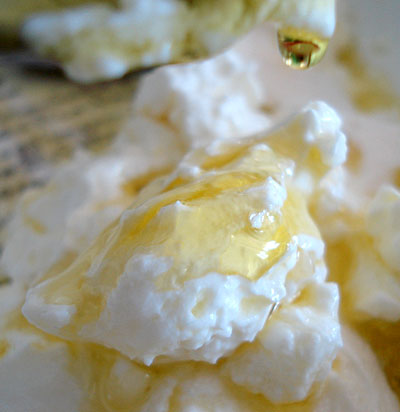
Hugh Fearnley-Whittingstall has an article about how to make yogurt (or as they spell it in the UK, yoghurt) in the Guardian. I did not want to go to the trouble of making yogurt from scratch, but I had a big pot of plain yogurt that needed to be used up so I made a sort of variation on the yogurt cheese balls further down on the page.
Yogurt cheese, in case you are unfamiliar with it, is just plain yogurt that has been drained of much of its liquid. To make it, just line a sieve with some porous cloth like cheesecloth, muslin, a coffee filter or even a couple of paper towels, spoon the yogurt in, and put the sieve with a bowl underneath in the refrigerator for at least a few hours. The more you let it sit, the drier it will become.
I strained about 2 1/2 cups of yogurt mixed with 1 teaspoon of sea salt from Friday evening to Sunday morning, by which time it had become the consistency of whipped cream cheese. I put this into a bowl, grated one garlic clove over it and drizzled on some extra virgin olive oil and mixed it up. It was the perfect spread for freshly baked hot savory scones.
I've never been a big fan of very sweet yogurt, so this savory yogurt spread may make more breakfast appearances.
Filed under:
breakfast party food dairy vegetarian

Even if I am Japanese, I don't like all Japanese food. And I must confess that I don't like a lot of traditional Japanese sweets that are based on sweetened beans. For the most part they are way too sweet for me, and if I make them for myself I'm always adjusting the sweetness level, as with my ohagi or botamochi.
Mitarashi dango, however, are my absolute favorite traditional sweet. They are not really that sweet really - that shiny caramel colored sauce (which is called mitarashi sauce) is sweet and savory at the same time. It goes perfectly with the bland, slightly chewy dango or dumplings. (Dango is the name for unfilled solid dumplings.)
You may see the dango just plained boiled more often than not. But grilling the dango makes them so much better, in my opinion.
Filed under:
dessert japanese party food wagashi
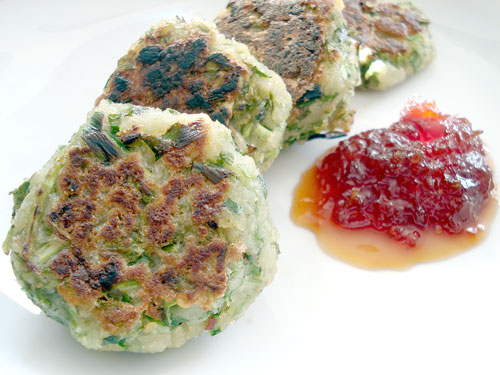
These tasty little savory cakes are made of ground lotus root. The texture is quite surprising - almost like mochi cakes. It's a great vegan, gluten-free savory snack that's high in fiber and packed with flavor.
Filed under:
party food vegetables vegetarian vegan gluten-free asian
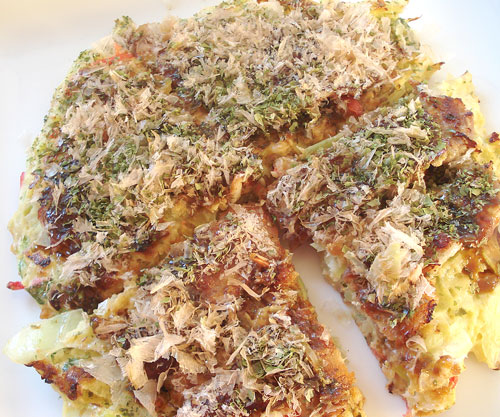
Okonomiyaki is getting slowly more popular outside of Japan. It's often described as a Japanese pizza, but it's more like a savory pancake.
Okonomiyaki was invented, they say, in Osaka, which is a city famous for cheap and good eats. Okonomiyaki is a snack more than a full meal, though it is pretty filling. It's a quintessential yatai or streetside food stand food, though nowadays you're more likely to eat it indoors than sitting at an outside stall. It's a very communal type of food, especially if you cook it on a tabletop griddle.
This is a fairly authentic recipe I think, or as authentic as a Tokyo born-and-bred girl can get.
Filed under:
japanese party food

If youre in the U.S. or anywhere in the world celebrating the 4th of July tomorrow, I hope you're having better weather than we're having here, where it's cold and rainy! If you're having a party, here are some useful recipes from the archives: Japanese potato salad, which in my opinion is the best kind of potato salad - rich tasting, not too vinegary. With homemade mayonnaise it's heaven - though be careful to refrigerate it properly before serving, and to eat the leftovers (if there are any) as soon as possible. For a much lighter salad (no fat added!), Scandinavian cucumber salad goes very well with the rich flavors of grilled meats. It's sort of like a fresh relish. By saving calories with the salad you can then splurge on the Red, white and blue mess for dessert, which looks quite spectacular and even feels sort of virtuously healthy because of all the fruit. Happy 4th!
Filed under:
party food holidays
Reader Nanette has posted a great question here, about hosting a fund-raising green tea tasting party for a large group (50 people). I had to think about this for a bit, and here are some of the ideas I have come up with.
Filed under:
party food tea
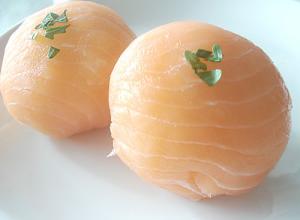
Following up on the previous recipe for shell shaped sushi, here is another kind of sushi that's great for parties. Temari are small cloth balls made from leftover scraps of kimono fabric, and temari zushi are meant to look like these colorful toys.
You can make temari zushi with any number of things, such as thinly sliced sashimi grade fish, boiled and butterflied shrimp, thinly sliced and cooked or uncooked vegetables, and even thin slices of cheese. You will likely never see temari zushi at a sushi restaurant - this is homey home-style sushi.
For these, I've used thinly cut slices of pale pink smoked salmon, with tiny amount of cream cheese inside, rather in the same vein as a New York Roll - quite non-traditional but it's a great combination. The key is to make the temari zushi on the small side since they are quite rich.
Filed under:
japanese party food spring rice sushi fish bento
Now that the weather is getting cooler, at least in these parts, there's nothing as appealing the smell of fresh baking filling the house. I don't think I have posted a simple baking recipe in a long time, so here's one that has become a favorite because it's so delicious and versatile. Here you see them in their cookie incarnation. (I used vegetable-shaped cookie cutters.)

Up close, for scale:
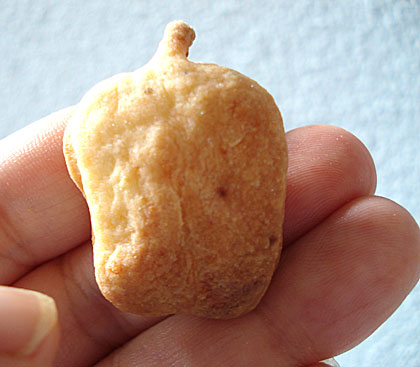
And here is the big scone incarnation:
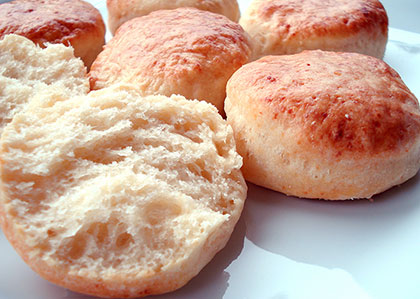
The recipe is based on one for English scones, but it's savory rather than sweet. Inspiration also came in part from Hungarian cheesy scones called pogasca, which I first had on a short trip to Budapest some years ago, and can't forget since. Depending on how big you make them, they can be fluffy-in-the-middle scones, or crispy yet soft little cookies, or biscuits for Brits. (Confusing the matter even further is of course that scones are very much like American biscuits.) In any case they are really easy to make, especially if you have a food processor.
These savory scones/biscuits/cookies are made with olive oil, which imparts the unique fruity-peppery taste of the oil, and also makes them theoretically a tiny bit healthier than using vegetable shortening or butter. You can use butter of course if you prefer that taste. (I hardly ever use vegetable shortening in my cooking, so I can't speak for it. I use lard sometimes, but that's another story.)
I have used three cheeses for this - Gruyère, feta and Parmigiano Reggiano (Parmesan) (plus cottage cheese), but you can use any bits of leftover hard or semi-soft cheese as long as it all adds up to about 1 cup in total.
If you make the scones very small and bake them until they are quite crunchy on the outside, they make perfect nibbles for a wine tasting. Make them larger and they are great fluffy biscuits/scones to have with a hearty soup or stew. You can also turn the large versions into very rich small sandwiches with a little roast ham or something in the middle.
These freeze beautifully and can be heated up in the oven, wrapped in foil, at 300°F/150°C for about 5 minutes for the little ones, 10-15 minutes for the big ones. The little ones can also be kept in an airtight cookie tin for about a week, so they are great to make ahead for a party.
Filed under:
bread party food quickbread scones biscuits cookies savory
Pages